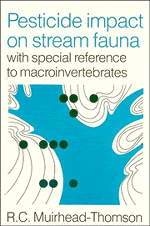Book contents
- Frontmatter
- Contents
- Preface and Acknowledgements
- PART I INTRODUCTION AND ORIGIN OF PESTICIDES IN RUNNING WATERS
- ONE Introduction
- TWO Origins of pesticides in running waters
- PART II THE ROLE OF LABORATORY AND EXPERIMENTAL METHODS IN EVALUATION
- PART III EVALUATION IN PEST CONTROL PROJECTS
- Summary and assessment
- References
- Index
TWO - Origins of pesticides in running waters
Published online by Cambridge University Press: 05 November 2011
- Frontmatter
- Contents
- Preface and Acknowledgements
- PART I INTRODUCTION AND ORIGIN OF PESTICIDES IN RUNNING WATERS
- ONE Introduction
- TWO Origins of pesticides in running waters
- PART II THE ROLE OF LABORATORY AND EXPERIMENTAL METHODS IN EVALUATION
- PART III EVALUATION IN PEST CONTROL PROJECTS
- Summary and assessment
- References
- Index
Summary
The term ‘pesticide’ embraces a wide range of toxic chemicals used for controlling or eradicating undesirable forms of life. Compounds specifically designed for the control of insects and other arthropods, i.e. insecticides, make up the bulk of these; another range of pesticides is designed to deal with undesirable fish (both predatory and competitive) while still others were developed for use against the aquatic snails which harbour intermediate stages of human parasites. The term pesticide now conveniently includes herbicides, chemicals specifically designed for control of undesirable plant growth, and this inclusion recognises the fact that the greatly increased use of herbicides in recent years has, in many cases, placed these chemicals equal to or ahead of insecticides as major environmental contaminants (Balk & Koeman, 1984)
CONTAMINATION AS A DIRECT CONSEQUENCE OF PEST CONTROL OPERATIONS
DIRECT APPLICATION OF PESTICIDE TO WATERBODY
Pesticide contamination of running waters can occur in many different ways and from many different sources, and may be only of short duration or it may be prolonged. In view of the emphasis in this review on the problems of evaluation, it would be convenient to consider pesticide contamination under two main categories. In the first category would be listed all those cases where the presence of pesticide in running water is the direct consequence of control operations carried out against undesirable fauna or flora.
- Type
- Chapter
- Information
- Pesticide Impact on Stream FaunaWith Special Reference to Macroinvertebrates, pp. 8 - 20Publisher: Cambridge University PressPrint publication year: 1987



